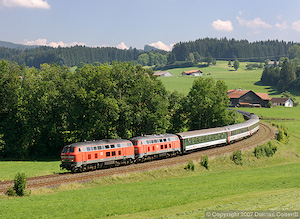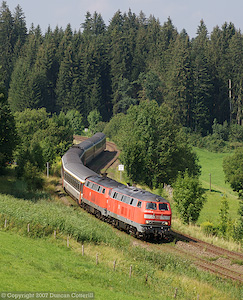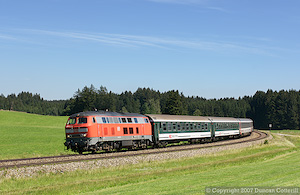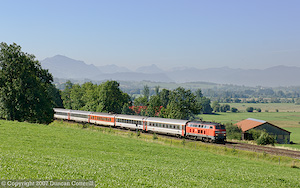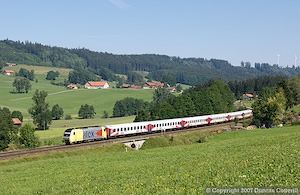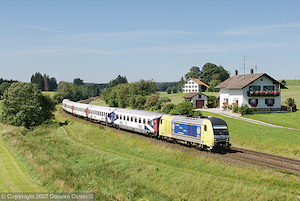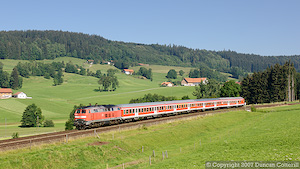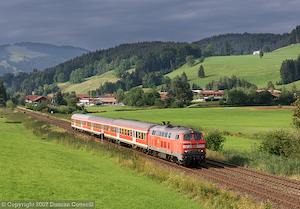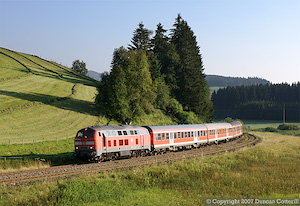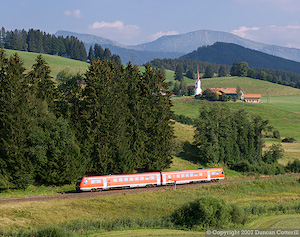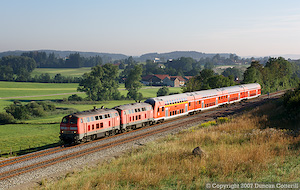Allgäu EuroCity Diversions
01 - 05 August 2007
Report by Duncan Cotterill
Introduction
Finding busy, scenic, diesel worked main lines in Europe isn’t easy these days. Most heavily-trafficked routes have been electrified for years. Those that remain unwired are often worked by DMUs or run through uninteresting country.
The Allgäubahn links München and Lindau via Kempten and is almost unique in being a busy and scenic double-track, non-electrified main line with a good number of locomotive hauled trains. I had visited the line before in July 2006 but only managed to get a fraction of the potential shots.
Several weeks of major engineering work between Buchloe and Memmingen provided the excuse for a return visit in early August 2007. Until 2 August, all München - Zürich EuroCity services were to be diverted via Kempten and that was an opportunity not to be missed. Chris Wilkinson and I spent five days on the line between 1 and 5 August 2007 in order to catch the last couple of days of the diversions and photograph the regular workings as well.
Travel & Accomodation
We flew to München and back with Lufthansa, experiencing the usual delays at Heathrow in both directions. In contrast, München Flughafen was slick and efficient and we were soon heading west towards the Allgäu.
I’d travelled by train and walked to the locations on the previous trip but this time we hired a car. The remaining stations on the Allgäubahn are quite widely spaced and walking to the more remote locations isn’t really practical (as my feet found out on the last trip).
Our base for the trip was Immenstadt, a pleasant little town in the Oberallgäu region of southern Bayern close to the Austrian border. It’s well situated in the middle of the scenic section of the line at the junction of the branch to Oberstdorf. We stayed at the Hotel Lamm, close to the town centre and station.
Photography
We concentrated on the scenic sections between Kaufbeuren and Hergatz where the line runs through superb hilly country dotted with picturesque farms and chocolate-box villages. The railway winds its way through the hills on an alignment that abounds with curves and gradients. It isn’t particularly well endowed with bridges and tunnels but there’s no shortage of excellent scenic shots.
Wednesday afternoon was bright and sunny but we struggled to get many good pictures. Our chosen location near Oberstaufen wasn’t difficult to find but getting to the spot was another matter. As a result, we didn’t do as well as we should have. Thursday dawned clear but the cloud soon streamed in from the west followed by heavy rain. In the end, we were lucky to get a single shot in good light. The cloudy weather continued through Friday but we did discover something to cheer us up.
While investigating some potential positions near Biessenhofen an eastbound EuroCity rolled past. The diversions should have finished the previous evening but they obviously hadn’t. A quick trip to Kaufbeuren station elicited the information that the work on the Memmingen line was overrunning and wouldn’t be finished until the following Tuesday so we still had a chance of getting the EC shots we wanted.
Saturday was just what we were waiting for; a beautiful clear sunny day with hardly a cloud in the sky. Our exploration over the previous two days really paid off and we bagged a bucketload of good shots at several different locations. Sunday morning was even clearer. Although the first few days had been difficult, Saturday and Sunday more than made up for the disappointment.
Passenger Services
Regional passenger services are sponsored by the Bayerische Eisenbahngesellschaft and most are operated by DB Regio with class 612 tilting DMUs or Kempten based class 218 diesels. At weekends a few Ulm based locos appear as well. Normally the 218s are paired with push-pull sets and haul from München, Augsburg and Ulm and propel in the other direction. This makes it easy to tell which end the loco will be at but it's difficult to get good pictures of eastbound trains.
The main services are hourly semi fasts from both Buchloe and Ulm via Kempten to Immenstadt where the trains connect. From Immenstadt, one train continues to Lindau while the other serves the branch to Oberstdorf. Destinations alternate, i.e. the train to Lindau comes from the Ulm direction one hour and the Buchloe direction the next. Services from Buchloe are usually through trains from either München or Augsburg.
The München - Oberstdorf service, which forms part of the pattern described above, is operated by ALEX (Allgäu Express) using class 253 diesels (Siemens ER-20, ÖBB class 2016) but all the other semi-fasts are DB trains. The ALEX trains are hauled in both directions and operate with a second loco on the back between Immenstadt and Oberstdorf to avoid having to run round at the terminus.
There are also a few stopping passengers worked by DB Regio class 628 or 642 railcars or occasionally class 218s on hauled or push-pull stock. In practice it’s difficult to tell the difference between the semi-fast RE services and the stopping RB trains as most of the small stations that only the RBs would normally stop at have been closed.
The most interesting trains are the few remaining EC and IC services. There are two ICs each day from Oberstdorf, one to Augsburg and the other to Magdeburg via Ulm. These trains are formed of DB IC stock and hauled by Ulm based class 218s. The Ulm train is double headed north of Immenstadt.
Most of the EC trains between München and Zürich usually run via Memmingen, leaving only one pair of trains via Kempten. Of these, only the westbound working runs in daylight. All the ECs are formed of Swiss stock and booked for double-headed Mühldorf based class 218s. During the engineering occupation all four pairs of ECs ran via Kempten and six of the eight trains were photographable.
Most trains ran as booked. One local passenger rostered for a 218 was a unit on Wednesday and one train booked for 612s ran with 642s on Friday. A number of ECs, all booked for pairs of 218s, ran with a single engine. There didn't seem to be a pattern to this so it may just have been poor availability. Everything else had the booked power. Timekeeping was pretty poor overall and particularly for the ECs. Our actual observations are detailed on the sightings page including the loco numbers.
Freight Services
Freight trains are few and far between with nothing running west of Kempten on a regular basis. There aren’t many trains east of Kempten either, just a couple of oil trains every week hauled by class 232s and a daily pick-up goods with a 294. We only saw one train, a westbound pick-up heading from Buchloe to Kempten behind a 294 on Friday morning.
Conclusions
The trip didn’t get off to the best start with missed opportunities on the Wednesday afternoon followed by two days of cloud and rain on Thursday and Friday. The dull days weren’t wasted though and the time we spent exploring really paid off when the sun came out on Saturday morning. The final day and a half more than made up for the shaky start. The wet early summer had left the landscape far greener than it usually is by August and the light was unbelievably clear. In short, perfect conditions to photograph trains, especially red trains in the glorious green scenery of the Allgäu. I was more than satisfied by the results.
The Allgäubahn is a treat to photograph with gorgeous locations and plenty of trains, around half of them worked by DB class 218 or ALEX class 253 locos. A fair proportion are pushers but the diagrams indicate which trains are booked to be pushed and are generally reliable. These can be found at www.v160.de but you have to register then sign in to access them. The two-letter codes indicate the position of the loco in the formation and anything with an A or an X as the second letter has the loco at the front. Codes with a B or a Y indicate a loco mid train and a C or a Z means the loco is at the back. No code also means that the train is hauled. Even the DMUs are fairly photogenic, especially when they run in 4 or 6 car formations.
A number of freights are due to be diverted from the Arlberg route to the Allgäubahn between 14 and 28 August and there is another period of EC diversions from 30 October to 5 November. Intending visitors should be aware that the Allgäubahn itself is closed in various places for engineering work much of the time between 1 September and 18 November.
The longer term future is unclear with electrification on the cards for the parallel route to Lindau via Memmingen and a big change in regional services due from the December 2007 timetable change. A press release from the Bayerische Eisenbahngesellschaft, sponsor of regional passenger services in Bayern, outlines the proposed changes (in German) . It appears that there will be 2-hourly trains from München, Augsburg and Ulm to Oberstdorf, each of which will detach a portion for the Lindau line at Immenstadt. How this will work in practice and what traction will be used isn’t clear yet. The one thing we can be sure of is that things will be different next year.
The Allgäubahn is undoubtedly one of the best diesel worked lines in Europe today and it's well work making the effort to get the shots before things change too much. Don't delay too long.
